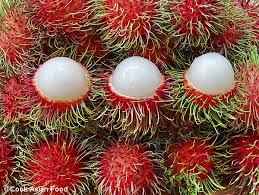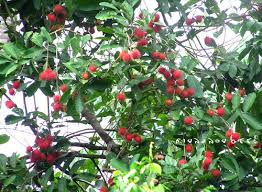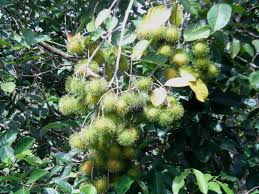RAMBUTAN
Rambutan is an
evergreen tree growing to a height of 12–20 m and in Malaysia it is considered as a local timber woods.
The leaves are alternate, 10–30 cm long, pinnate, with 3-11 leaflets, each leaflet 5–15 cm wide and 3-10 cm broad, with an entire margin. The flowers are small, 2.5–5 mm, apetalous, discoidal, and borne in erect terminal
panicles 15–30 cm wide.

Rambutan trees are either male (producing only staminate flowers and, hence, produce no fruit), female (producing flowers that are only functionally female), or
hermaphroditic (producing flowers that are female with a small percentage of male flowers).

The fruit is a round to oval
drupe 3–6 cm (rarely to 8 cm) tall and 3-4 cm broad, borne in a loose pendant cluster of 10-20 together. The leathery skin is reddish (rarely orange or yellow), and covered with fleshy pliable spines, hence the name
rambutan, derived from the Malay word
rambut which means hairs. The fruit flesh is translucent, whitish or very pale pink, with a sweet, mildly acidic flavour. The single seed is glossy brown, 1–1.3 cm, with a white basal scar. The seed is soft and crunchy. They are mildly poisonous when raw, but may be cooked and eaten.
 Rambutan
Rambutan is a popular garden fruit tree and propagated commercially in small
orchards. It is one of the best known fruits of Southeast Asia and is also widely cultivated elsewhere in the tropics including
Africa, the
Caribbean islands,
Costa Rica,
India, Indonesia, the Philippines, and Sri Lanka. Thailand is the largest producer from
Surat Thani Province Thailand. Rambutan production is increasing in
Australia and, in 1997, was one of the top three tropical fruits produced in
Hawaii. It is also produced in Ecuador where it is known as "achotillo."
The fruit are usually sold fresh, used in making jams and jellies, or canned. Evergreen rambutan trees with their abundant coloured fruit make beautiful landscape specimens.
Rambutan found in markets that is harvested as picked from their stems, is commonly ridden with insects, prone to rot, and of relatively low viability per bunch sold, especially compared to other fruits. The best quality rambutan is generally that which is harvested still attached to the branch. It is less susceptible to rot, damage, and pests, and remains fresh for a much longer time than rambutan that has been picked from the branch.
No comments:
Post a Comment